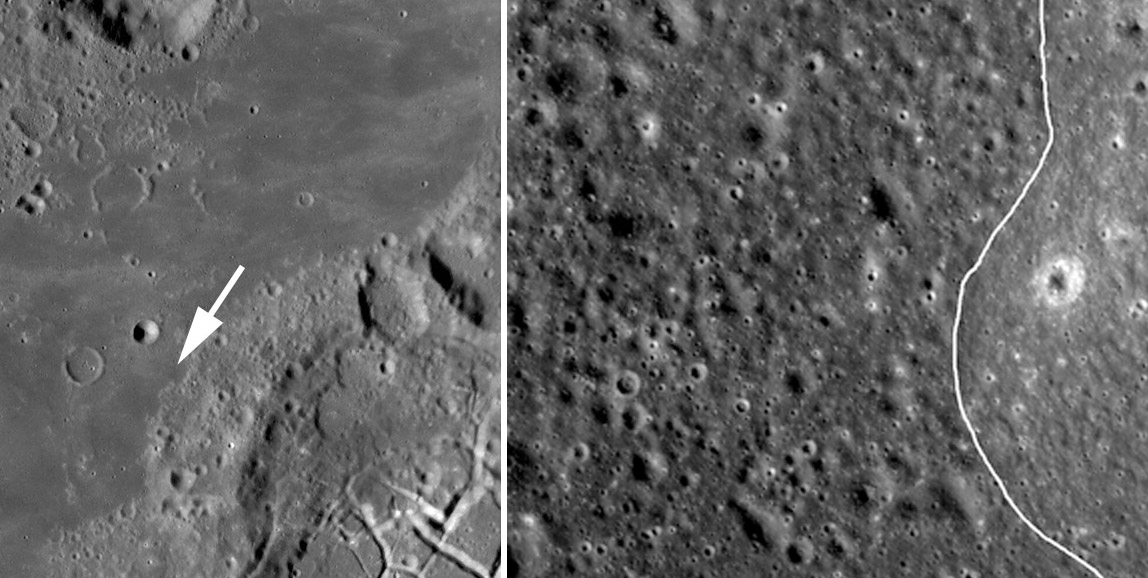Difference between revisions of "January 11, 2010"
| Line 3: | Line 3: | ||
<!-- ws:start:WikiTextHeadingRule:1:<h1> --> | <!-- ws:start:WikiTextHeadingRule:1:<h1> --> | ||
<!-- ws:start:WikiTextLocalImageRule:16:<img src="/file/view/LPOD-Jan11-10.jpg/112660657/LPOD-Jan11-10.jpg" alt="" title="" /> -->[[File:LPOD-Jan11-10.jpg|LPOD-Jan11-10.jpg]]<!-- ws:end:WikiTextLocalImageRule:16 --><br /> | <!-- ws:start:WikiTextLocalImageRule:16:<img src="/file/view/LPOD-Jan11-10.jpg/112660657/LPOD-Jan11-10.jpg" alt="" title="" /> -->[[File:LPOD-Jan11-10.jpg|LPOD-Jan11-10.jpg]]<!-- ws:end:WikiTextLocalImageRule:16 --><br /> | ||
| − | <em>images from [http://lroc.sese.asu.edu/news/index.php?/categories/2-Featured-Image | + | <em>images from [http://lroc.sese.asu.edu/news/index.php?/categories/2-Featured-Image LROC News System], NASA & ASU</em><br /> |
<br /> | <br /> | ||
| − | LRO has been collecting high resolution images of Constellation Program [/January+9%2C+2010 Regions of Interest (RoI)]. The LRO web [http://lroc.sese.asu.edu/news/index.php?/archives/164-Mare-Moscoviense-Constellation-Site.html#extended | + | LRO has been collecting high resolution images of Constellation Program [/January+9%2C+2010 Regions of Interest (RoI)]. The LRO web [http://lroc.sese.asu.edu/news/index.php?/archives/164-Mare-Moscoviense-Constellation-Site.html#extended site] released this wide angle (left) and the narrow angle (right - about 1.8 km wide) camera views as samples of the data collection. The left view shows part of the rim and mare covered floor of the farside [http://the-moon.wikispaces.com/ROI+-+Mare+Moscoviense Moscoviense Basin RoI], and the right is a closeup of the mare/rim contact. The scientific rationale for this RoI is to sample a large farside mare and perhaps its inner basin ring via the rim of the floor-fractured crater [http://the-moon.wikispaces.com/Komarov Komarov]. Notice anything unexpected about the closeup view, showing the younger basalt (left on right image) and the older rim (right)? The young mare has more impact craters than the older rim - how can that be? I suggest that the flat mare floor preserves craters formed there longer than does the inclined rim; although the rim slope looks small. Notice the gentle ridges on the rim paralleling the mare/rim contact. It looks like this is rim material that has moved downslope, presumably erasing craters as it went. <br /> |
<br /> | <br /> | ||
| − | <em>[mailto:tychocrater@yahoo.com | + | <em>[mailto:tychocrater@yahoo.com Chuck Wood]<br /> |
<br /> | <br /> | ||
Mark Tillotson reminds us that the Lunar Prospector went into orbit around the Moon on this date in 1998!</em><br /> | Mark Tillotson reminds us that the Lunar Prospector went into orbit around the Moon on this date in 1998!</em><br /> | ||
<br /> | <br /> | ||
<hr /> | <hr /> | ||
| − | <div>You can support LPOD when you buy any book from Amazon thru [http://www.lpod.org/?page_id=591 | + | <div>You can support LPOD when you buy any book from Amazon thru [http://www.lpod.org/?page_id=591 LPOD!]<br /> |
</div> | </div> | ||
---- | ---- | ||
===COMMENTS?=== | ===COMMENTS?=== | ||
| − | + | Register, and click on the <b>Discussion</b> tab at the top of the page. | |
Revision as of 16:14, 11 January 2015
Roi - Mare Moscoviense

images from LROC News System, NASA & ASU
LRO has been collecting high resolution images of Constellation Program [/January+9%2C+2010 Regions of Interest (RoI)]. The LRO web site released this wide angle (left) and the narrow angle (right - about 1.8 km wide) camera views as samples of the data collection. The left view shows part of the rim and mare covered floor of the farside Moscoviense Basin RoI, and the right is a closeup of the mare/rim contact. The scientific rationale for this RoI is to sample a large farside mare and perhaps its inner basin ring via the rim of the floor-fractured crater Komarov. Notice anything unexpected about the closeup view, showing the younger basalt (left on right image) and the older rim (right)? The young mare has more impact craters than the older rim - how can that be? I suggest that the flat mare floor preserves craters formed there longer than does the inclined rim; although the rim slope looks small. Notice the gentle ridges on the rim paralleling the mare/rim contact. It looks like this is rim material that has moved downslope, presumably erasing craters as it went.
Chuck Wood
Mark Tillotson reminds us that the Lunar Prospector went into orbit around the Moon on this date in 1998!
COMMENTS?
Register, and click on the Discussion tab at the top of the page.



